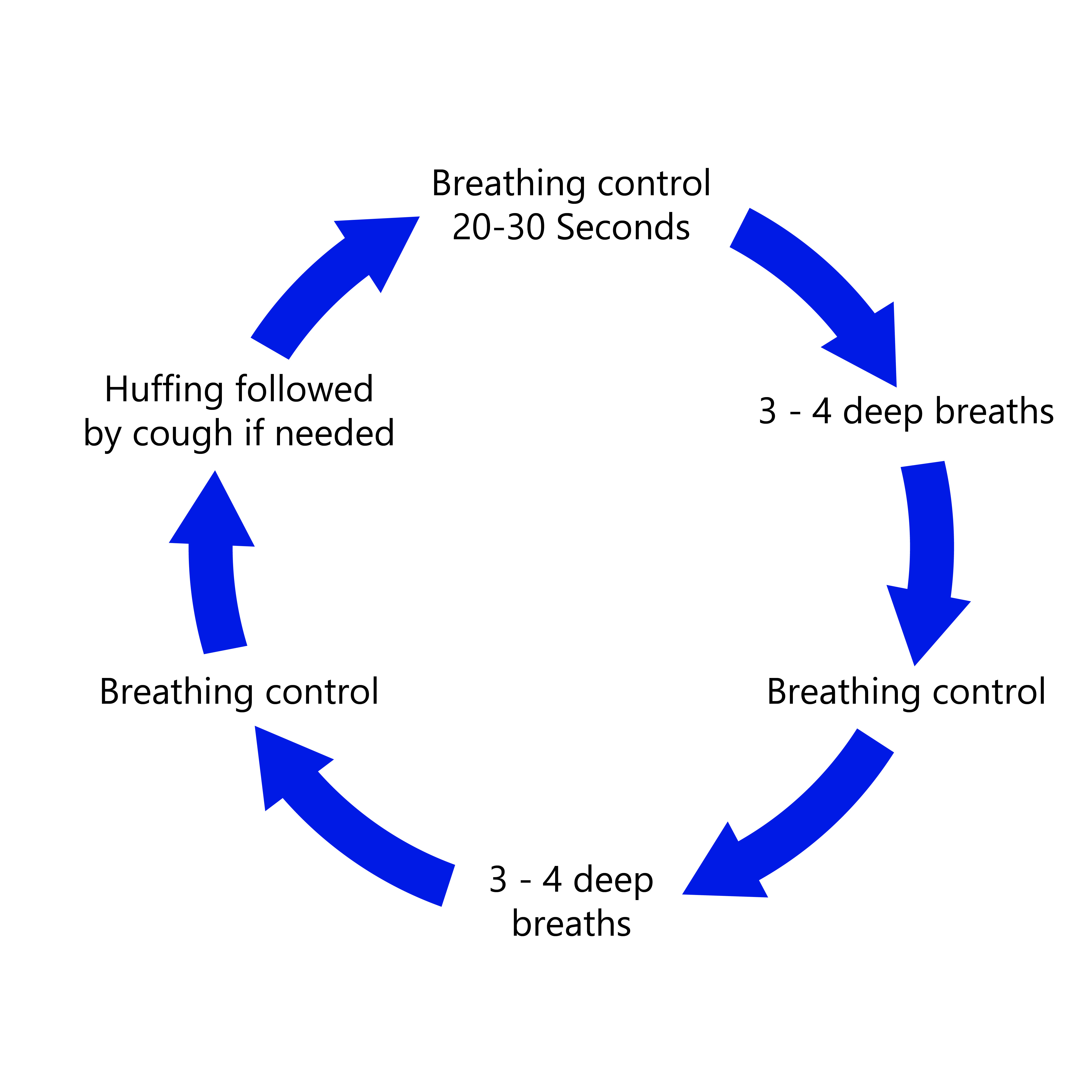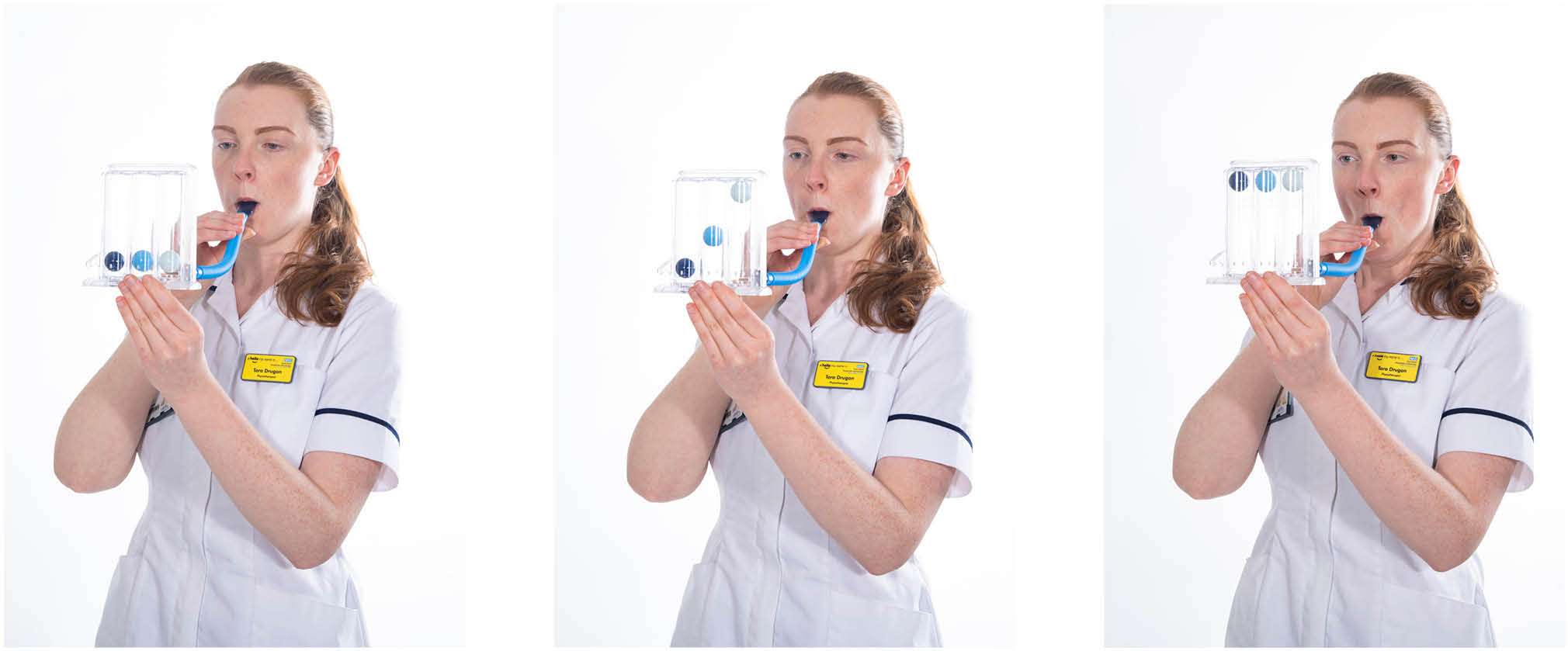Breathing exercises after surgery
Information for patients from the Physiotherapy Department
After surgery it is very important to complete regular deep breathing exercises, as advised by your physiotherapist. At this time you are at higher risk of developing a chest infection and these exercises will help prevent that from happening.
This leaflet explains:
why breathing can be difficult following surgery
what the cycle of breathing technique is; and
why it’s important to get out of bed as soon as you are able following surgery.
If you have any questions after reading this booklet, please speak to your physiotherapist.
Why is breathing sometimes more difficult after surgery?
Ordinarily, mucous (sputum) is produced in your lung tissue every day. Sputum is important for trapping any bacteria, dust, or inhaled debris. Breathing deeply allows air to pass through all areas of your lungs. It helps move sputum back up to your mouth and out of your airway; removing the bacteria / dust / inhaled debris with it.

After surgery, breathing deeply may be difficult due to pain. If this happens, your lungs do not work as well, leading to a higher risk of developing a chest infection.
To help your lungs work properly after surgery, we suggest you carry out some breathing exercises. These exercises will help to make your lungs stronger, and hopefully prevent you from developing a chest infection.
What is the cycle of breathing technique?
The cycle of breathing technique is a useful way of clearing sputum from your lungs. These exercises should be done regularly throughout the day. Your physiotherapist will guide you.
It is normal after abdominal surgery for these exercises to be uncomfortable. Sometimes both coughing and deep breaths may cause pain. It is important to speak with nursing staff to make sure that your pain is managed well enough to allow you to complete these exercises.
Aim to complete the cycle of exercises sitting upright in a chair or in a bed.

Breathing Control: take slow deep breaths in through your nose and out through your mouth as normal. Complete 5 times.
Thoracic Expansion Exercises: take deep breaths in through your nose to fill your entire lung space. It can be helpful to place your hands on your lower ribcage when carrying out these exercises.
Add a “sniff” at the end when your lungs are full, so more air can enter the smaller air sacs in your lungs. Complete 5 times.
Return to breathing control, or move to stage 3 if you have been advised by your physiotherapist to do so, or if you feel you have something to cough and clear.
Complete a “huff”, if you feel like you have sputum on your chest or have been advised by your physiotherapist. This is like trying to fog up glasses. The “huff” will help move sputum upwards through your lungs to help you prepare for coughing.
Supported cough and clear secretions. Repeat as necessary. Remember you may need to do this a few times before secretions are successfully coughed up or spat out.

Coughing is important to prevent chest infections and retained sputum. It can cause pain around the area of your surgical wound, yet it is still important to cough and take deep breaths.
To do this, you may wish to “support” your cough or deep breath. You can hug a pillow or rolled-up towel around the painful area, to provide you with support when coughing. This can help reduce your discomfort. Your nurse or physiotherapist can guide you with this if needed.
Move around and get out of bed as soon as possible after surgery
As well as doing breathing exercises, it is also very important to get out of bed as early as medically possible after surgery. This allows your lungs to fully expand with air. Your nurse or doctor will tell you when this is safe to try.
Remaining in bed for long periods of time is not good for breathing. It puts you at increased risk of developing complications after surgery.
What is incentive spirometry?
If you are having problems taking slow deep breaths, hospital staff may recommend you use an incentive spirometer.
To use a spirometer
Place the mouth piece in your mouth and suck in. Take a slow deep breath and fill your lungs with air.
Try to hold the balls at the top for 2 to 3 seconds. Aim to get all three balls in the air.
Complete 5 breaths once per hour, to make sure you are getting regular deep breaths.

Further information
If you have any questions or concerns about your breathing or the exercises outlined in this leaflet, please speak to your physiotherapist.
Physiotherapy contact: _____________________________________________